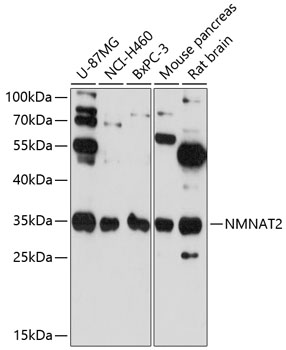-
Product Name
NMNAT2 Polyclonal Antibody
- Documents
-
Description
Polyclonal antibody to NMNAT2
-
Tested applications
WB
-
Species reactivity
Human, Mouse, Rat
-
Alternative names
NMNAT2 antibody; C1orf15 antibody; PNAT2 antibody; nicotinamide nucleotide adenylyltransferase 2 antibody
-
Isotype
Rabbit IgG
-
Preparation
Antigen: Recombinant fusion protein containing a sequence corresponding to amino acids 1-302 of human NMNAT2 (NP_733820.1).
-
Clonality
Polyclonal
-
Formulation
PBS with 0.02% sodium azide, 50% glycerol, pH7.3.
-
Storage instructions
Store at -20℃. Avoid freeze / thaw cycles.
-
Applications
WB 1:500 - 1:2000
-
Validations

Western blot - NMNAT2 Polyclonal Antibody
Western blot analysis of extracts of various cell lines, using NMNAT2 antibody at 1:3000 dilution.Secondary antibody: HRP Goat Anti-Rabbit IgG (H+L) at 1:10000 dilution.Lysates/proteins: 25ug per lane.Blocking buffer: 3% nonfat dry milk in TBST.Detection: ECL Basic Kit .Exposure time: 60s.
-
Background
Nicotinamide/nicotinate-nucleotide adenylyltransferase that acts as an axon maintenance factor (By similarity). Catalyzes the formation of NAD(+) from nicotinamide mononucleotide (NMN) and ATP. Can also use the deamidated form; nicotinic acid mononucleotide (NaMN) as substrate but with a lower efficiency. Cannot use triazofurin monophosphate (TrMP) as substrate. Also catalyzes the reverse reaction, i.e. the pyrophosphorolytic cleavage of NAD(+). For the pyrophosphorolytic activity prefers NAD(+), NADH and NaAD as substrates and degrades nicotinic acid adenine dinucleotide phosphate (NHD) less effectively. Fails to cleave phosphorylated dinucleotides NADP(+), NADPH and NaADP(+). Axon survival factor required for the maintenance of healthy axons: acts by delaying Wallerian axon degeneration, an evolutionarily conserved process that drives the loss of damaged axons (By similarity).
Related Products / Services
Please note: All products are "FOR RESEARCH USE ONLY AND ARE NOT INTENDED FOR DIAGNOSTIC OR THERAPEUTIC USE"
